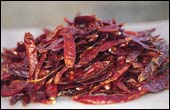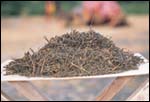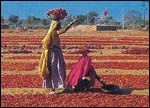


 Kair Sangri Kumita
Kair Sangri Kumita
Out of wild berries growing freely in the Thar desert, one of Marwari cuisine�s signature dishes was born, writes ROOP KUMAR JAIN. |
|
ONE of the great Marwari dishes in Rajasthani cuisine, is the piquant and tangy Kair Sangri Kumita. It is a simple vegetarian preparation that does not really reflect the richness of this colourful school of cooking. Because Kair, Sangri and Kumita are not exotic vegetables that are exclusive to Rajasthan. Instead, they are wild berries (or beans) that grow independently and abundantly in the vast Thar desert, and which are available for the picking.
The story goes that Kair Sangri Kumita was discovered ages ago by Rajasthani villagers during the time of a great famine. All other natural vegetation, which was anyway scarce in the desert, had withered and died away. But Kair (small, raddish-like pods), Sangri and Kumita (longish beans) flourished unconcernedly in the punishing Rajasthan sun. Intrigued by the very appearance of these berries, and delighted by their availability, the villagers plucked all three and took them home.
There, Kair, Sangri and Kumita were put to the test. There was no water for cooking because of the famine, so the villagers kept the berries to dry and sourced out vegetable oil to do their cooking in. Having got mustard oil, they put into their experiment whatever else had survived the famine and was at home on their kitchen shelves. These included the ubiquitous red Mathania chillies of Jodhpur, amchur (raw mango), salt and yoghurt. Using all these, and the sun-dried Kair, Sangri and Kumita, they made a pickle that was wonderful to eat with their bajra (millet) rotis.
Incredibly, Kair Sangri Kumita continues to be prepared in this simple manner, and is rated as one of the mainstays of the Marwari kitchen even in this day and age of 21st century cooking. It has a long shelf life when made as a pickle, and loses none of is pungency even when consumed several months later. However, most Marwari families use Kair, Sangri and Kumita as a fresh vegetable. They soak it in water overnight and cook it with masalas in a yoghurt gravy. Rajasthanis also use Kair, Sangri and Kumita along with two other ingredients, the dried red Mathania chillies and whole amchur, to make another popular Marwari vegetable in oil called Panchkuta.
Lal Badshah!
ABOUT 80 kilometres outside Jodhpur in the dry and arid district of Mathania, grow beautifully-shaped red chillies that are of great value to Rajasthani cooking. The weather conditions in Mathania are extremely tropical during the months between March and July, and it is in this season that the chilli grows.
Because it is identified with this district only and is not found growing elsewhere in Rajasthan), this variety of chilli has come to be known simply as the "Mathania lal mirch". It is expensive, because its value in cooking has been appreciated by the outside world as well, and the Mathania mirch gets exported in huge quantities to the Arab nations.
In Marwari and Rajput cooking, the Mathania mirch is used only as a dry spice. It lends pungency to a dish, and also colour and body. Some Rajasthanis soak the chilli when it is fresh in mustard oil, and consume it later as a pickle. It is their big regret that bulk of the crop every season gets exported, and the rest is bought up by the hotel and restaurant industry. There is very little to spare. Bania shops in market places are careful how much of the 'Lal Badshah' they sell to whom.
And now, the Rajasthanis have heard that Mexican chefs have discovered the Mathania mirch and are raving about how well it adapts itself to their fiery and flavorsome cuisine. They don't know whether to be pleased or dismayed by this. The Mexicans are wanting to know why the Jodhpuris cannot mass-produce the Mathania lal mirch. They want to experiment with growing it in Mexico. As if they don't have enough of chillies with their Habaneros, Poblanos, Serranos, Pasillas, Mulatos, Anaheims, Chipotles, Guajillos, Anchos and Jalapenos already!
|

Home Page
About the mag
Subscribe
Advertise
Contact Us

